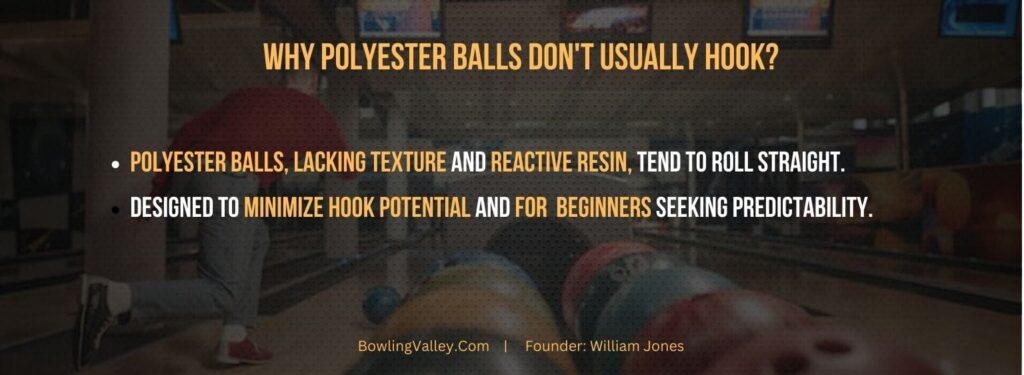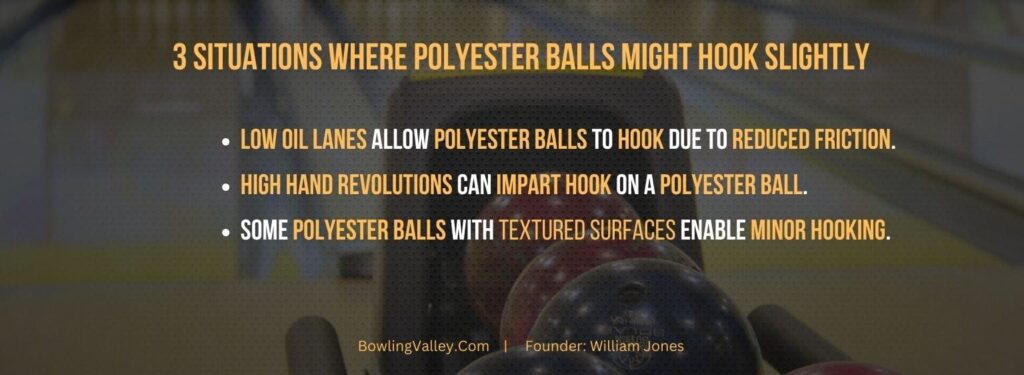Did you know that polyester bowling balls are known for their straight line and lack of hook potential?
Well, it’s true!
In this article, we’ll explore why polyester balls typically don’t hook and the rare situations where they might surprise you.
So, if you’re curious about the science behind bowling ball hooks and how it applies to polyester balls, keep reading to discover all the fascinating details.
Jump to a Specific Section
- 1 2 Reasons: Why Polyester Balls Don’t Usually Hook?
- 2 3 Situations Where Polyester Balls Might Hook Slightly
- 3 Closing Words: “Do Polyester Bowling Balls Hook?”
- 4 Frequently Asked Questions
- 4.1 Are There Any Exceptions to the Rule That Polyester Bowling Balls Don’t Usually Hook?
- 4.2 Can Polyester Balls Hook in Certain Lane Conditions or Oil Patterns?
- 4.3 Are There Any Techniques or Adjustments That Can Be Used to Make a Polyester Ball Hook?
- 4.4 Do Polyester Balls Hook More or Less Than Other Types of Bowling Balls?
- 4.5 Are There Any Specific Situations or Scenarios Where Using a Polyester Ball Would Be Advantageous for a Bowler?
2 Reasons: Why Polyester Balls Don’t Usually Hook?

1. Lack of Surface Texture and Reactive Resin
To understand why polyester balls don’t usually hook, it’s important to consider the absence of surface texture and reactive resin, which are vital for hooking in other ball types.
Unlike other bowling balls, polyester balls have a smooth surface texture.
This lack of texture reduces the friction between the ball and the lane, making it difficult for the ball to grip the lane and create a hook.
Additionally, polyester balls don’t contain reactive resin.
Reactive resin is a type of coverstock that enhances the ball’s grip on the lane and increases its hook potential.
Without reactive resin, polyester balls lack the ability to generate the necessary amount of friction needed for a significant hook.
2. Primarily Used for Spares and Beginners Due to Their Straight Trajectory
When using polyester bowling balls, you can rely on their straight trajectory for spares and beginners.
Unlike other ball types that have surface texture and reactive resin, polyester balls are designed to minimize hook potential.
This makes them ideal for picking up spares, as they’ll travel in a straight line without veering off course.
Whether you’re aiming for the 7-pin or the 10-pin, the predictable path of a polyester ball can help increase your spare conversion rate.
Additionally, for beginners who are still learning to control their shots, polyester balls provide a consistent and stable delivery.
Here is what one of my bowling friends Sarah said,
“Polyester balls are my secret sauce! When I started, I couldn’t hit the pins if they were right in front of me. Polyester changed the game.
Now, it’s like my bowling balls have GPS. Straight shots, fewer gutter balls – it’s a beginner’s best friend.”
See, they allow you to focus on your technique and accuracy without worrying about the ball curving unexpectedly.
You May Wanna Read: Why Bowling Ball Won’t Hook Anymore?
3 Situations Where Polyester Balls Might Hook Slightly

Let’s discuss all of them in detail.
1. Very Low Oil Lanes – Less Friction, Allowing Even Polyester Balls to Hook Slightly
Low oil lanes reduce friction, enabling polyester balls to hook slightly. When the oil on the lane is very low, there’s less lubrication between the ball and the lane surface.
This lack of lubrication allows the polyester ball to grip the lane more effectively, resulting in a slight hook potential.
The reduced friction allows the ball to grab the lane and change its direction slightly as it rolls towards the pins.
However, it’s important to note that the hook potential of polyester balls on very low oil lanes is still limited compared to reactive resin or urethane balls.
Nevertheless, even in low oil conditions, polyester balls can provide a small amount of hooking action.
2. Bowlers With Naturally High Hand Revolutions Can Impart Some Hook On a Polyester Ball
Bowlers with high revolutions can generate hook on a polyester ball due to their naturally high hand revolutions.
When you have a strong release and high rev rate, the rotational force applied to the ball increases, causing it to grip the lane more aggressively.
This increased friction allows the polyester ball to hook.
The high revolutions create a skid-roll-hook motion, where the ball skids through the oil, transitions into a rolling motion, and then hooks towards the pins.
This can be advantageous in certain situations where you need the ball to break towards the pocket or navigate tricky lane conditions.
However, it’s important to note that the amount of hook generated by polyester balls with high revolutions is still significantly less compared to reactive resin or urethane balls.
3. Specific Polyester Balls – Slightly Textured Surface, Enabling Minor Hooking
Certain polyester balls have a slightly textured surface, allowing them to generate minor hooking in specific situations.
These polyester balls are designed with a purpose – to provide bowlers with an option for controlling their shots on dry lanes.
The textured surface creates a small amount of friction between the ball and the lane, causing it to hook slightly.
This can be useful when facing dry lane conditions where a straight shot may not be effective.
By using a polyester ball with some hook potential, you can adjust your line and angle to accommodate for the lane conditions and increase your chances of hitting the pocket.
Though polyester balls can hook on dry lanes, their hook potential pales compared to reactive resin or urethane, making them better for spares.
You May Wanna Read: 4 Basic Shots In Bowling
Closing Words: “Do Polyester Bowling Balls Hook?”
In conclusion, polyester bowling balls are typically known for their straight trajectory and lack of hook potential.
However, in certain situations where lane conditions are extremely dry or when thrown with an unusual release technique, polyester balls can surprise bowlers with a slight hook.
Just remember, while they may occasionally ‘break the mold,’ polyester balls are still generally considered the straight shooters of the bowling world.
Frequently Asked Questions
Are There Any Exceptions to the Rule That Polyester Bowling Balls Don’t Usually Hook?
Polyester bowling balls don’t usually hook, but sometimes you’ll find one that surprises you. They may exhibit some hook on specific lane conditions or oil patterns. The degree of hook is influenced by factors such as the lane surface, the quantity of oil, and the bowler’s technique.
Can Polyester Balls Hook in Certain Lane Conditions or Oil Patterns?
In certain lane conditions or oil patterns, polyester balls can hook. The amount of hook will depend on the lane surface, amount of oil, and the bowler’s technique.
Are There Any Techniques or Adjustments That Can Be Used to Make a Polyester Ball Hook?
You gotta finesse it, buddy. Polyester balls might not naturally hook, but with the right techniques and adjustments, you can make that baby curve like a pro. It’s all about skill and strategy.
Do Polyester Balls Hook More or Less Than Other Types of Bowling Balls?
Polyester bowling balls do not hook as much as other types of bowling balls. However, there are techniques and adjustments you can use to make a polyester ball hook slightly.
Are There Any Specific Situations or Scenarios Where Using a Polyester Ball Would Be Advantageous for a Bowler?
In certain situations, using a polyester ball can benefit you as a bowler. When the lane conditions are dry or you need a straighter trajectory, the polyester ball’s low hook potential can be advantageous.
